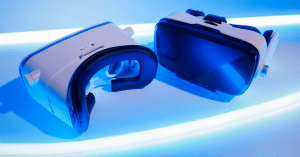
When shopping for virtual reality devices, you have probably encountered the term “spatial computing.” What does it mean? And how does it change your VR experience?
Spatial computing refers to different technologies that allow human-computer interactions in the physical world. Unlike traditional computing, spatial computing doesn’t occur inside the computer environment, behind the monitor screen.
This article will teach you the deeper meaning of spatial computing. We’ll cover how it works and what benefits you can expect. We’ll even share popular examples of spatial computing devices below.
What Is Spatial Computing?

Spatial computing describes various technologies that blend virtual reality with the physical world. These include the following:
- Augmented Reality (AR) – It enhances the physical world by introducing computer-generated content. These can be visual elements, sounds, and other stimuli.
- Virtual Reality (VR) – It is a computer-generated environment with 3D objects. VR offers completely immersive digital experiences that feel real.
- Mixed Reality (MR) – It combines both physical and digital experiences. It allows real and virtual objects to co-exist in real-time.
Spatial computing allows human-computer interactions in the real world instead of inside the computer or phone screen. Individuals can engage with digital content as if it is a part of the physical environment.
The concept of spatial computing teaches computers to understand and communicate with people more naturally in the human world. It inverts the standard practice of training humans to interact with computers.
How Does Spatial Computing Work?

Spatial computing works by combining virtual and physical environments in a seamless way.
It uses multiple sensors to track human movements in the real world. These include depth cameras, RGB cameras, 3D trackers, and other tools.
It also relies on computer vision to understand the environment and the objects around it. It processes data from the sensors to create an accurate and comprehensive view of the world.
Spatial computing even uses mixed reality (MR) and augmented reality (AR) to add virtual elements to the real world. These 3D graphics provide information in a natural way compared to the traditional 2D screens. For example, they are useful when buying a piece of furniture. They can place a virtual image of the furniture in your living room to give you an idea of what it looks like before purchasing.
However, spatial computing isn’t limited to visual output. It can also be present in high-tech headphones. For instance, it can produce sounds that constantly exist in the space near the headphone wearer. It offers contextual audio information spatially.
What Are the Benefits of Spatial Computing?
Spatial computing technology offers many benefits to users.
First, it encourages real-time collaboration through the metaverse and extended reality. At the same time, it allows you to interact with machines and virtual environments in a seamless and natural way.
Spatial computing also has positive effects on productivity. It improves workflows as users can quickly access crucial information and assets in an accessible environment.
Spatial computers also provide more engaging training experiences and simulations. They enable team members to interact with possible real-world scenarios safely and innovatively within a secure space.
Spatial computing technology can even benefit the customer service industry. It allows employees to examine and resolve problems remotely. Despite offering remote solutions, spatial devices help companies build more personalized experiences.
Plus, it promotes sustainability by reducing on-site travel. Professionals can visualize and fix problems by using VR headsets with spatial functionality.
Finally, spatial computing can minimize operational costs. Although spatial devices tend to be expensive upfront, they can save you money and time over time. They improve productivity and solve different business issues without needing experts on the ground.
What Are Examples of Spatial Computing Devices?
Spatial computing may seem like a complex topic. However, it already has a huge influence on how people live today.
Below are some popular examples of spatial computing devices.
Apple Vision Pro

The Vision Pro is the first spatial computer from tech giant Apple. It uses 3D cameras, advanced sensors, and surround sound systems to combine real and virtual environments. It lets you view virtual objects with the real world as the background.
Besides serving as a spatial computer, the Apple Vision Pro also acts as a virtual reality headset. It provides complete immersion in the computer-generated world that feels real.
Unfortunately, the high price tag of the Vision Pro limits it to tech enthusiasts and professionals.
Meta Quest Pro
The Meta Quest Pro is a relatively affordable virtual reality headset with spatial computing abilities. It makes mixed reality experiences accessible to average consumers.
It features two LCDs with passthrough functionality. It can blend the real world with computer-generated elements.
However, the Meta Quest Pro is geared towards gamers and media enthusiasts rather than professionals.
Microsoft HoloLens 2

Before the Apple Vision Pro and Meta Quest Pro, Microsoft had already made waves in the spatial computing industry with the HoloLens 2.
This ergonomic holographic device fully integrates with the Microsoft ecosystem. It enables professionals to collaborate in real-time using OneDrive, Power BI, and Dynamics 365 for Field Service.
The HoloLens 2 is available in different versions to suit various business applications. It warrants a high price tag because it provides immersive experiences designed for professional use.
IKEA Place
IKEA Place is an augmented reality (AR) application that uses spatial computing technology. It helps individuals visualize a piece of furniture in any given space, such as a bedroom or office. Every IKEA product is available in 3D and true-to-scale view.
Overall, the app can assist you in buying the right furniture for your home.
Mercedes-Benz Virtual Remote Support
Mercedes-Benz collaborated with Microsoft to create the first mixed-reality automotive maintenance support system.
It uses spatial computing technologies to help technicians solve business problems within hours instead of days. It also enables workers to collaborate with Mercedes-Benz specialists anywhere in world. They can provide insight and guidance without leaving their office, ultimately saving the company time and money.
What Is the Future of Spatial Computing?
After learning the definition and benefits of spatial computing, you may be curious to know about the future of this technology.
Spatial computers are expected to grow at a steady rate between 2024 and 2030. Major tech companies are already invested in this market.
Meanwhile, the latest entrance of Apple in the spatial technology industry got most people to wonder the same thing. Will it be a failure or a defining moment? However, Apple has a history of setting standards, from the iPod to the iPhone. So, we’ll just wait and see if the Vision Pro leads to a rise in new and innovative spatial computing applications.
Conclusion
Spatial computing enables human-computer interactions in a natural way by combining different technologies. It combines the real world with a computer-generated environment. It offers several benefits, from increased productivity to real-time collaboration. The most popular current examples of spatial computers include Apple Vision Pro and the Microsoft HoloLens 2.
Do you have other questions about spatial computing or spatial technology? Visit our contact page to send your queries!






